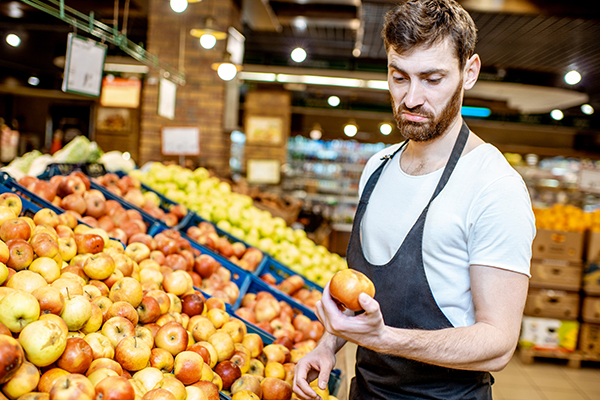Food Defense Playbook
In the last blog, we raised the question of whether a defensive position is really needed for retail foodservices. I hope you were convinced that incorporating some defensive measures into daily practices will protect food inventory from risks–whether those risks are theft, spoilage, or intentional contamination. After all, food in inventory belongs to the operation so it makes sense to protect it from any risks while in your custody.
Intentional contamination is one of the risks that we have to recognize is real in today’s world, regardless of who is the perpetrator. Security cameras are helpful and can serve as a deterrent, but most defensive measures are common sense and relate to controls for access and opportunity.
The Food and Drug Administration has good information and useful tools for the food industry available here. USDA has developed a guide for schools to use in development of a food defense plan. While these resources won’t pertain specifically to your operation, they will provide ideas for what controls may be needed and tips on on implementation.
Limiting access and opportunity for someone to commit harm is just good business sense. There are areas of the operation that should be off limits to unauthorized people. Think about which categories of people are in and out of your operation– staff, customers, and vendors – and which areas of the foodservice they should be able to access.
First, think about your staff. There are likely permanent, full-time employees along with part-time staff. Hiring is a critical step – check references and ask others within your networks for referrals to be sure you don’t bring a bad apple on board. Some operations limit access for staff to locations needed for their job responsibilities. Most retail operations won’t issue keys or convey passwords to everyone. For example, a wait staff member doesn’t need to have a key to the walk-in cooler or liquor storage, and a salad prep employee doesn’t need to have access to the office. Further, there is no reason for a wait staffer, or other non-prep staff, to being in the food production or food storage areas. This can be a problem in schools or other onsite foodservices where the only ice machine is in the kitchen; non-nutrition program staff (even administrators) may feel free to waltz in and help themselves! When hired, staff need to be informed about authorized areas and places in the operation for which they do not have access. Warehouse operations often will use security badges or color-coded badges by accessible work zones. Clear signage provides direction and reminders of policy.
A second group of people around your operation, obviously, are customers! Customers are key to the success of your foodservice operation because without them, you don’t have a business! However, that does not mean they can wander throughout the operation. Plus, your chef likely would not appreciate unsolicited advice! Doors and signs are good ways to politely communicate areas are off limits. Doors into the kitchen – from inside the operation as well as those outside – should always be kept closed. What about self-service or buffet service? Designating a staff member in that area to monitor customers’ actions (you’ve seen that person who uses the serving spoon as a tasting tool!) is a best practice. The bonus is there is a staff member who can also respond to questions and keep the self-service areas looking attractive while replenishing food and utensils as needed in addition to keeping an eye out for any trouble.
Vendors who supply your foodservice with supplies have a difficult job, and this can be made worse if located in highly populated areas with heavy traffic. Best practice for receiving is to accept product only when foodservice staff is there to inspect it, and to accept only from an identified delivery person. We have all seen the movies where the bad guys hijack a delivery truck for access into the operation! Key drops are convenient, but before you go this route, be sure to vet the supplier and ask about their hiring practices. My local school provides keys to the dairy vendor because deliveries are made at 3 AM. (Why they aren’t made during the time staff are present is beyond me because school nutrition programs are open 6 AM to 2 PM usually)! One time though, the vendor delivery person lost all of the keys he had – not only for my district but for several others in the area. Talk about a mess!
And again, who is the vendor’s rep that has access to YOUR food supply and to the operation? Back when I worked in college dining, we discovered (when the problems were not going away) that the pest control operator was really a card carrying member of PETA! He had infiltrated the company with the purpose of saving the pests!
Opportunities to intentionally contaminate the food exist. The goal of an operator is to minimize this risk. Locking exterior doors from unauthorized outside access, even during hours of operation, is a smart move. Training all staff to being alert to unusual circumstances is another important action step. FDA has some good signage as part of the See Something, Say Something campaign. Consider downloading, printing, laminating, and posting in a few key places of your operation.
Limiting the opportunities for intentional food contamination with good hiring practices, use of locks and issuance of keys as needed to trusted staff, and restricting access within the operation based on work responsibilities are good starting points. Encouraging staff to monitor what is going on around them and to report unusual practices or unsafe conditions are also good steps to take. Empowering them to raise questions and correct situations as needed helps avoid a tattle-tell culture while building a sense of ownership in the success of the foodservice. Remember that it was employees who noticed the cult member attempting to contaminate the salad bar with salmonella. All of this is part of developing a safe food culture.
Risk nothing!
READ MORE POSTS
The Alphabet Soup of Hepatitis and Why it Should Concern Foodservice Operators.
Late in July, I was made aware that World Hepatitis Day was on July 28th. I do have to be honest – similar to most of you reading this, I was surprised there was such a thing. After doing a bit of research, I discovered July 28th was named as such to recognize the birthday of Dr. Baruch Blumberg, who first discovered the hepatitis B virus in 1967 and then two years later developed the first hepatitis B vaccine. Each year, the Centers for Disease Control and Prevention and the World Health Organization recognize the day to help raise awareness about hepatitis, which impacts over 300 million across the globe and causes more than one million deaths a year.
Food Recalls: Another Important Reason to Have a Sound Traceability Program in your Foodservice Operation
Earlier in the month, I discussed a bit about the proposed traceability rules that may be coming out soon. One result of implementing the proposed rule and improving overall food traceability in your operation is the ability of those in the food chain to quickly identify and pull product involved in a food recall.











